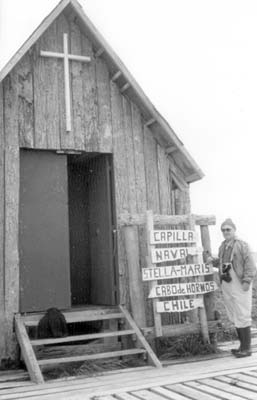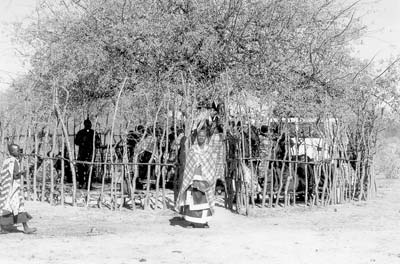Most beautiful or unusual place of worship
In our September ’06 issue we printed several readers’ selections of special places of worship. Here are a few more. If you have another to share, write to Standout Place of Worship, c/o ITN, 2116 28th St., Sacramento, CA 95818, or e-mail editor@intltravelnews.com (please include the address at which you receive ITN).
Of the hundreds of churches that my husband, Ed, and I have visited around the world, the most unusual place of worship that I have ever seen was not a church but a chapel.
Homeward bound after visiting Antarctica in February 1989, we stopped at the island of Cabo de Hornos off the southern tip of Chile where, very high on a hill overlooking Cape Horn, we found the Chapel of Stella-Maris.
It was an extremely difficult climb from the ship’s Zodiac, which waited for us at sea level. Once we were on shore, there were slippery boulders to cross in order to reach a makeshift slippery, steep, wooden stairway. At the top of the stairway we found ourselves on a grassy path with barbed wire on the right side. We were told that beyond the wire were minefields separating Chile from Argentina.
It seemed that we were on top of the world, looking down on the convergence of the two mighty oceans: the Atlantic and the Pacific. It was a breathtaking sight. Only a short distance away we saw a quaint little building.
Built of very rough wood, probably pine, the outside and inside of the small building revealed the ravages of time and extreme weather. Inside there was only one small room about a dozen feet long. In the center of the far wall was an altar made of a rough wooden plank set upon two tree trunks with loose bark still attached. Behind the altar was a large wooden cross that extended to the peak of the slanted roof.
The altar was covered with a white cloth with pretty pink flowers across the edge. On the altar itself were several small images and two vases of artificial flowers.
In the left-hand corner, on a larger tree trunk there was a very old statue of the Virgin Mary. Here and there on the walls were posted worn and soiled holy cards and prayer cards. On either side of an aisle there were six rather crude benches. An old cabinet was on the right of the altar holding various religious articles.
One can only imagine the plight of the many visitors who came here before us offering prayers of hope and thanksgiving. This was a perfect setting for us to give thanks for being in this spectacular place and for finding this lovely little chapel.
Marion Rafferty
Easton, PA
There are many beautiful places of worship in Germany: the cathedrals in Cologne and Ulm; the Asam brothers’ churches in Bavaria, and the small churches with altars carved by Tilman Riemenschneider.
Often overlooked is the Church of St. Lorenz in Nürnberg with its important works of art. Most outstanding is the “Annunciation” by Veit Stoss, a 12-foot-high rosary depicting Mary and the angel surrounded by a garland and medallions depicting the Seven Joys of Mary.
Also unique is the 59-foot-high limestone tabernacle with about 100 figures borne by the lifelike figures of Adam Kraft, the sculptor, and two of his assistants.
There are other great works by Stoss, a beautiful rose window and a fine hall choir. The church and its works of art date from the 13th to 15th centuries.
Nürnberg also offers its Frauenkirche and the church of St. Sebaldus, the latter almost entirely rebuilt after World War II. Sadly, two of the city’s great synagogues were destroyed by the Nazis on Kristallnacht and only memorial plaques marking their sites can be seen.
Bill Klett
Lilydale, MN
In Jerusalem, anyone can go to the Western Wall after going through security. When I was there in 1979, some individuals and small groups were praying. Many walked backward when leaving the wall so as not to turn their backs on it, but this is not essential. Today the Western Wall has Friday evening services and Bar Mitzvahs.
Women each should carry a shawl or scarf, as they should not have bare shoulders or legs in religious places.
Nancy Hesselbrock
Cincinnati, OH
Also, men are required to wear a head covering at the Western Wall. Some paper yamulkas, as well as short-skirt covers for ladies, are available on site to be borrowed.
One of my greatest joys of travel over the years has been to not just visit empty churches but to actually worship and/or experience musical performances. I have been an organist and choir director for many years, and the music is a real bonus. Most of my traveling companions in the past years have been from my church, so we have had a special interest in houses of worship.
• I would like to second the recommendation of the person who mentioned the “rock church” in Helsinki, Finland (Sept. ’06, pg. 40). A friend and I were on a Princess cruise in the Baltics in 2003, and we visited Helsinki on our own with a daily tram pass.
We were in the church only a few minutes when the organist sat down and began to play. When she finished, I asked if she would play just a few bars from one of my favorite songs. She replied that she was in a rush but I was welcome to play as long as I wanted. I am not too good without sheet music, but I was thoroughly enjoying myself when the tour bus showed up from the ship with many of our friends. We had a wonderful hymn sing, including many Christmas carols.
• Another recommendation I would make is the cave church in Budapest, which I visited in 2004. It had been closed under the Communists but is once again an active church. It is conveniently located across the street from the Gellert Hotel & Baths.
• Other favorites are the cave churches of Matera, Italy (where Mel Gibson’s “The Passion of the Christ” was filmed), and, nearby, the “trulli” church in Alberobello, where in 2003 we happened upon a funeral in progress. In San Gimignano, Italy, in 2003 we attended Mass in the church with the beautiful frescoes (including “Santa Fina”) that were featured in the movie “Tea with Mussolini.”
• Since our pastor was with us on several trips, we held our own worship services in equally inspiring surroundings. In Austria in 1998, part of my choir was in our group, and in a farmyard we sang “On Eagles’ Wings” with the Alps for our dome.
• In the salon of a 17th-century château in 2001, accompanied by a beautiful white antique piano, we sang “Walking on High Places” the day after we viewed this part of France from the top of a puy (extinct volcano).
• In Slovenia in 2005, on another beautiful Sunday morning, we worshiped on the balcony of our guest house overlooking Lake Bled and then shortly after came upon a German garden club holding worship in the Church of the Assumption on the island in the lake. At the end of the service, we took turns ringing the bell (on Saturdays, grooms carry their brides up the 99 steps to the church and then ring the bell for a happy marriage).
• I saved the most memorable two for last. One was the celebration of the first Communion for the youngest member of our group in the “Upper Room” in Jerusalem.
• And in fall 2005 I was privileged to be a part of a mission trip to visit our companion synod in Tanzania. We spent one afternoon and evening in a Maasai village, where we worshiped with them in their “church,” a structure of sticks pounded in the ground in a circle around a tree for shade. The “pews” were made of sticks tied together. After worship, we were treated to a feast of mbuzi (barbecued goat) under the most spectacular starry sky I have ever seen.
These are some of the experiences that have made my travels so much more rewarding than just seeing the statue in the square of General So-and-So with the pigeon on his head.
Judy Pfaffenberger
Toledo, OH


